 Characters created by detective writer Masao Shiro in his series of tales, bannered "The Casebook of the Young Samurai Lord," found their way from newspaper serials into several films.
Characters created by detective writer Masao Shiro in his series of tales, bannered "The Casebook of the Young Samurai Lord," found their way from newspaper serials into several films.
Yataro Kurokawa was the first actor to portray Young Lord Samurai in Wakasama samurai torimonocho: Nazo no nomen yashiki (Shin Toho, 1950) & its sequel Wakasama samurai torimonocho: Noroi no ningyo-shi (Shin Toho, 1951), co-starring Denjiro Okochi, a leading man in the silent era & great character actor as he aged.
The first Casebook of Young Lord Samurai film was hastily made from a script written practically overnight by Umetsugu Inoue, who drew only character & general mood from the original stories, & Nazo no nomen yashiki was like a British sitting-room "cozy" taking place entirely in interiors of an inn.
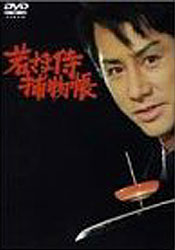 The director of the first two films, Nobuo Nakagawa, was best known for his samurai ghost story films, & brought a degree of gloominess to the stories, so that Wakasama Samurai began in cinema a little more serious-seeming than most "family" or youth-oriented samurai tales. The director of the first two films, Nobuo Nakagawa, was best known for his samurai ghost story films, & brought a degree of gloominess to the stories, so that Wakasama Samurai began in cinema a little more serious-seeming than most "family" or youth-oriented samurai tales.
He's a man-about-town, meaning Edo, who comingles equally with peasants, shopkeepers, gangsters, & vassal samurai.
He obviously has a reputation, even if anonymously, & one of the influences on his nature would seem to be Sherlock Holmes as private investigator, distinct from the "Edo magistrate" genre of samurai detectives which originate in Edo Period literature.
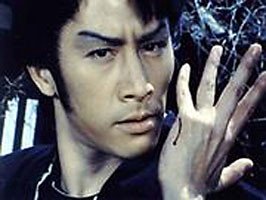 The literary precursors include the magistrate tales of Ihara Saikaku (1642-1693), which make more historical sense because obviously magistrates have not just the right but the duty to barge in & investigate crimes. The literary precursors include the magistrate tales of Ihara Saikaku (1642-1693), which make more historical sense because obviously magistrates have not just the right but the duty to barge in & investigate crimes.
A ronin about town never revealing his actual identity had no such privileges historically speaking, despite the assumption of the Wakasama Samurai series.
For television, 18 episodes of Wakasama Samurai Torimono-cho were first aired from 18 May 1978 to 19 September 1978, starring Yonosuke Ito. Issued in 2003 a Region 2 dvd boxed set, but not subtitled.
The defining performer was Hashizo Okawa who between 1956 & 1962 made seven or eight films playing the detective Young Lord Samurai.
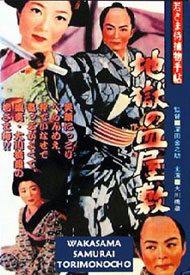 Case of Young Lord Part I (Toei, Wakasama Samurai Torimono-cho: Jigoku no Sarayashiki, 1956) begins with an enka or folksong style theme song, "Wakasama Zamurai," behind the opening credits. This pleasing song opens each episode, & was a hit single for enka singer Yukio Hashi.
Case of Young Lord Part I (Toei, Wakasama Samurai Torimono-cho: Jigoku no Sarayashiki, 1956) begins with an enka or folksong style theme song, "Wakasama Zamurai," behind the opening credits. This pleasing song opens each episode, & was a hit single for enka singer Yukio Hashi.
A little while later the heroine Okiyo will have a themesong, a similarly folksy tune, so the film very nearly qualifies as a "singing samurai" movie, though not quite, except in its overall sweetness.
There've been a few variant titles for this film in English subtitled releases, including Diary of a Wandering Lord. Wakasama is by no means a wanderer, however, being a man-about-town, something of a dandy, in the great city of Edo.
Nor does "Torimono-cho" quite mean "diary," but it's close; it's a "case book," & the films in this series present cases from Wakasama's record of cases solved.
The story proper begins on a dark city street, with very few people abroad. A noodle vendor has set up his after-hours movable stand & the scarred yakuza gangster Yasuzo says "Pops! A bowl!" They hear a scream from down the street, then an apparent thief wearing an oni devil mask runs is pursued into the darkness.
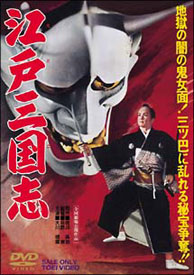 It's an atmospheric beginning. Soon we have a few pieces of information about the curious "almost crime." It's an atmospheric beginning. Soon we have a few pieces of information about the curious "almost crime."
On the previous night, someone broke into the first of three kuros or warehouses belonging to a recently deceased pawnbroker. On the present night, the second of the warehouses was broken into. Yet in neither case was anything stolen.
Our samurai detective known only as "Wakasama Zamurai" has his curiosity piqued & is soon investigating. It's assumed the third house will be broken into on the third night. Wakasama will be there to catch the housebreaker.
Addressed exclusively by the honorific "Wakasama" meaning "Young Lord," no one ever seems to know our hero's real name. It's an affectation of the series that he never has to prove he has the right to gain access to wherever crimes occur; even magistrates who do have that right just take him for granted.
Some he doesn't have to prove he's really a "young lord" though the title implies he's the heir of an important clan. In the course of Part I, someone does note he's actually "a nobody," specific identity unknown as he pursues his hobby, with most people (the innocent ones at least) quickly eager for him to succeed.
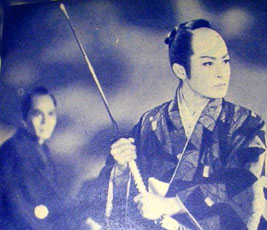 Wakasama immediately suspects the oni-masked housebreaker, being no thief, is seeking something that he has a right to possess. Wakasama ends up assisting the non-thief the next night, first in an amusing encounter during which the masked figure refuses under any circumstance to speak. Wakasama immediately suspects the oni-masked housebreaker, being no thief, is seeking something that he has a right to possess. Wakasama ends up assisting the non-thief the next night, first in an amusing encounter during which the masked figure refuses under any circumstance to speak.
Bemused Wakasama has thus established the basis of a "relationship" with the "thief" on which to build the possibility of trust later in the tale. And when the housebreaker is cornered by the magistrate & his underlings, Young Lord Samurai steps in to help the masked figure escape.
The one-against-all sword fights are nicely choreographed. But this is essentially a children's movie, so another affectation of this film, & the entire series, is that it is possible to get into swift battles with swords all around, without anybody getting hurt.
Wakasama even prefers to use the backside of his sword, so he can strike oponents without risk of cutting them. He presumedly such a super-swordsman that even very skillful duellists are never the least threat to his success. So the appeal of watching him duel is never in the suspense but only in the dance.
Soon it's well known what the masked figure is after. The deceased moneylender was not an honest man. He had taken advantage of an impoverished clan of very low-ranking vassals to the shogunate, talking them into pawning their family heirloom, a Gosu plate received as a gift from an the second Tokugawa shogun, passed down through the Yamaoko clan lineage.
When for a festival day the low vassals are asked to exhibit their rare plate in the current shogun's palace, the pawnbroker refuses to permit the family to borrow it on the basis of honor. He is forcing them to redeem the plate with the cash required, though knowing full well they cannot do so. When the pawnbroker is subsequently found dead of "natural" causes, the plate is nowhere to be found.
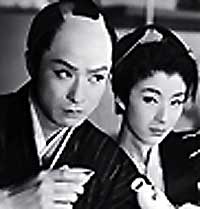 Wakasama has doubts about the "natural" death, & in fact has doubts that the pawnbroker Hikobei is even dead. The doctor who said so has made himself unavailable since that night. Wakasama has doubts about the "natural" death, & in fact has doubts that the pawnbroker Hikobei is even dead. The doctor who said so has made himself unavailable since that night.
Finding the plate is absolutely essential, for if it becomes known to the Shogun that his ancestor's gift to the small clan was pawned, such an insult to the shogunate must result in the little clan being abolished.
Just as Wakasama is about to close in the hide-out of the purportedly dead Hikobei, he finds himself under attack for a climactic one-against-all duel. His two sidekicks, who exist mainly as comic relief, avoid confrontation since neither can fight. It's all up to Wakasama.
We never worry Wakasama can't take a dozen swordsmen pretty easily. But in a nearby tree one of the hooded attackers has a musket. The last image of the episode is a cliffhanger. The bullet clearly fired from the steadied musket, in a manner that could not possibly miss Wakasama. Oh no!
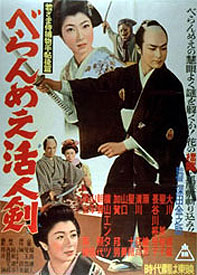 Case of Young Lord Samurai Part II (Wakasama Samurai Torimono-cho: Zoku Jigoku no Sarayashiki, 1956) picks up at exactly that moment, & surprise-surprise, Wakasama wasn't shot dead. Case of Young Lord Samurai Part II (Wakasama Samurai Torimono-cho: Zoku Jigoku no Sarayashiki, 1956) picks up at exactly that moment, & surprise-surprise, Wakasama wasn't shot dead.
The film cheats a bit since we saw the musket fire without inerference. But it's replayed at the beginning of Part II, & this time the mysterious oni-masked housebreaker tosses an object causing the gunner to fire into the sky.
"I'm not a turnip!" exclaims Wakasama. "You can't kill me that easily!" He continues the one-against-all battle until everyone gives up & runs away.
The scene is additionally a cheat because the previous film wanted the mass duel to be seriously fought & Wakasama did not use the backside of his sword. Presumedly he killed a few of these men. But in the replay at the beginning if Part II they all run off without so much as a limp.
These two rather short films are really one long film, but it was typical in the '50s to do them in two parts, & force theater-goers to pay to see the films serially, each showing for a week. Later episodes in the series, however, will be complete stories per film.
So in terms of "cases" there are only six films despite that seven films were distributed. The first four of these films are presently available through the brown market with subtitles, but they're placed on three discs because honestly #1 and #2 are one film.
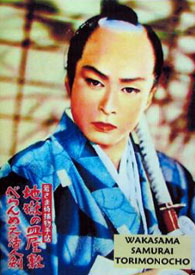 It's up to Wakasama to find the plate in time for it to go on display in the palace in two days time. If the plate cannot be recovered, the innocent little clan will be ruined. It's up to Wakasama to find the plate in time for it to go on display in the palace in two days time. If the plate cannot be recovered, the innocent little clan will be ruined.
Along the way we must discover not just where the plate is hidden, but who is the oni-masked hosuebreaker (the answer is a delightful though not entirely unpredictable surprise); who wants the innocuous Yamaoka clan ruined; who killed Hikobei that same night Wakasama discovered he'd previously faked his death; & will Sayuri really be forced to marry the dupicitiously "helpful" highly placed vassal Dewa Yokogawa.
Plus there is a romantic subplot of a love story between Okiyo, whose father Hotei-ya alas is one of the bad guys, & Ryunosuke of the Yamaoka clan. There romance somewhat parallels the more whimsical affair between reluctant Wakayama & his regular girlfriefnd Oito, who has her own enka folksong theme.
[SPOILER ALERT!] A key action scene regards Wakasama & Oito trapped in a cellar with a mechanical ceiling being lowered to crush them. Quite a set-piece right out of some old mantinee serial.
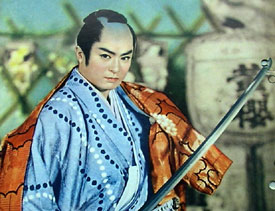 But for the final & revelatory arrival of the oni-mask mysterious stranger, Wakasama & his girlfriend wouldn't've made it out alive. But for the final & revelatory arrival of the oni-mask mysterious stranger, Wakasama & his girlfriend wouldn't've made it out alive.
This sequence, too, encompasses length two-against-all swordfighting as the oni-masked stranger fights side by side with Wakasama, & relative to the rest of the film, this final sustained fight sequence actually is rather frighteningly violent.
Needless to say, it'll all work out for the best for the good guys, not so great for the bad guys; & if the audience had gotten too accustomed to the mildness of the violence throughout these first two episodes, the fate of the two worst bad-guys will be a little shocking.
In this final battle, Wakasama wears garments that feature his family crest, so for the first time his "identity" is partially revealed, in that the Tokugawa crest means he's related to the Shogun. In most episodes of this series this is simply never revealed, but it's a given fact for the character, known to Japanese viewers of the day from the literary source, & not really a "surprise" revelation (except to bad-guys) as it may seem to western viewers.
The crest gives Wakasama enormous privileges, to arrest, to kill, & no opponent dares strike back as to do injury to the Tokugawa family crest is an insult, punishable by death, to the Shogun himself.
Perhaps because the series is more for kiddies than for adults, it rarely quite admits the full background story for nameless "Young Lord" who is (like Shingo Aoi of another series of films starring Hashizo Okawa) no mere relation, but is the bastard son of the Shogun, living the free life of a town dandy & playboy but semi-secretly with access to considerable resources.
On the one hand he has developed a reputation for being a dandy, nameless ronin, bohemian layabout, but on the other hand the whole neighborhood & beyond knows he's the guy to see if there's a murder to be solved. [END SPOILER ALERT]
In the coda following the fairly violent climax (violent by family-film standards & by most of this pair of films until the end), everything is shown to be restored to sweetness & sunlight & wind-socks overhead & the enka folksong "Wakasama Zamurai" sung at Boy's Day Festival by all the nice characters plus a street full of children. The only lingering worry for Wakasama regards Oito's troubling insinuations that they get married just like Ryunosuke & Okiyo plan to do.
copyright © by Paghat the Ratgirl
|
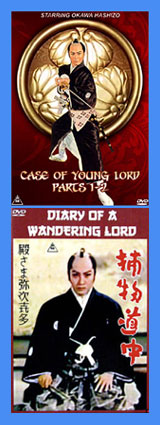

 The director of the first two films, Nobuo Nakagawa, was best known for his samurai ghost story films, & brought a degree of gloominess to the stories, so that Wakasama Samurai began in cinema a little more serious-seeming than most "family" or youth-oriented samurai tales.
The director of the first two films, Nobuo Nakagawa, was best known for his samurai ghost story films, & brought a degree of gloominess to the stories, so that Wakasama Samurai began in cinema a little more serious-seeming than most "family" or youth-oriented samurai tales.  The literary precursors include the magistrate tales of Ihara Saikaku (1642-1693), which make more historical sense because obviously magistrates have not just the right but the duty to barge in & investigate crimes.
The literary precursors include the magistrate tales of Ihara Saikaku (1642-1693), which make more historical sense because obviously magistrates have not just the right but the duty to barge in & investigate crimes.
 It's an atmospheric beginning. Soon we have a few pieces of information about the curious "almost crime."
It's an atmospheric beginning. Soon we have a few pieces of information about the curious "almost crime." Wakasama immediately suspects the oni-masked housebreaker, being no thief, is seeking something that he has a right to possess. Wakasama ends up assisting the non-thief the next night, first in an amusing encounter during which the masked figure refuses under any circumstance to speak.
Wakasama immediately suspects the oni-masked housebreaker, being no thief, is seeking something that he has a right to possess. Wakasama ends up assisting the non-thief the next night, first in an amusing encounter during which the masked figure refuses under any circumstance to speak. Wakasama has doubts about the "natural" death, & in fact has doubts that the pawnbroker Hikobei is even dead. The doctor who said so has made himself unavailable since that night.
Wakasama has doubts about the "natural" death, & in fact has doubts that the pawnbroker Hikobei is even dead. The doctor who said so has made himself unavailable since that night.
 It's up to Wakasama to find the plate in time for it to go on display in the palace in two days time. If the plate cannot be recovered, the innocent little clan will be ruined.
It's up to Wakasama to find the plate in time for it to go on display in the palace in two days time. If the plate cannot be recovered, the innocent little clan will be ruined. But for the final & revelatory arrival of the oni-mask mysterious stranger, Wakasama & his girlfriend wouldn't've made it out alive.
But for the final & revelatory arrival of the oni-mask mysterious stranger, Wakasama & his girlfriend wouldn't've made it out alive.